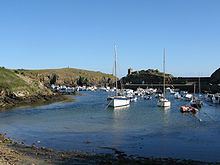Country France Department Vendée Population (2006) 5,001 Area 23.32 km² | Region Pays de la Loire Canton L'Île-d'Yeu Time zone CET (UTC+1) Arrondissement Les Sables-d'Olonne | |
 | ||
Points of interest Pointe des Corbeaux lighthouse, Dolmen De La Planche A Puare, Plage des Sables Rouis, Fort de Pierre‑Levée, Île d'Yeu lighthouse | ||
Île d'Yeu ([il djø]) is an island and commune just off the Vendée coast of western France. The island's two harbours, Port-Joinville in the north and Port de la Meule, located in a rocky inlet of the southern granite coast, are famous for the fishing of tuna and lobster.
Contents
Map of %C3%8Ele d'Yeu, 85350 %C3%8Ele d'Yeu, France
Administratively, the commune of L'Île-d'Yeu (with that spelling) forms part of the Vendée department and the Pays de la Loire region of France.
The island is reached by ferry from Fromentine or Saint-Gilles-Croix-de-Vie. Air transportation is available at Île d'Yeu Aerodrome (IATA: IDY, ICAO: LFEY), with commercial service from Nantes Airport.
History
Neolithic markings in the native stone and an unusual concentration of megalithic dolmens and menhirs attest to the island's early sanctity. Irish monks from Bangor, County Down, dedicated their monastery on the Île d'Yeu to Hilaire; Saint Amand, from Poitou received early training there, but it was destroyed by Viking raiders in the ninth century.
During the tenth century, monks from Marmoutier near Tours and monks of Saint-Cyprien at Poitiers built a new monastery and dedicated it to Saint Stephen. The castle built on an islet linked to the coast by a bridge is first mentioned in 1356.
Since the nineteenth century Île d'Yeu has attracted many artists. Jean Rigaud (1912–1999), official painter to the French Navy, had a house there, as did Maurice Boitel (1919–2007). Jean Dufy (1888-1964) l made about twenty paintings of l'Ile d'Yeu during several summer stays between 1926 and 1930.
The proclaimed hero of Verdun and the leader of France's wartime collaborationist Vichy régime, Philippe Pétain, died in prison on the island in 1951 and is buried there.
The poet Marc-Adolphe Guégan, an early French exponent of haiku, lived on the island until his death in 1959.
The island's seaweeds have been the subject of studies by the French marine biologist Françoise Ardré.
